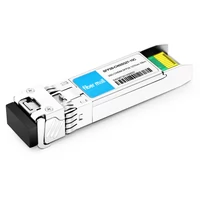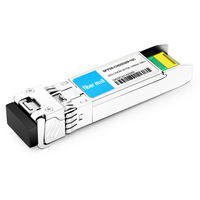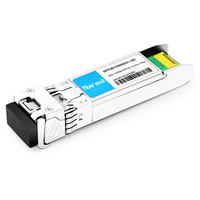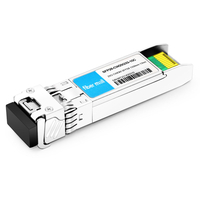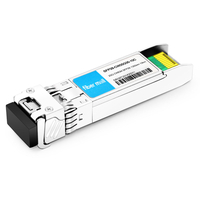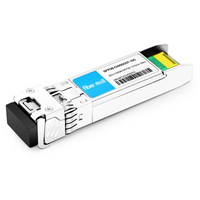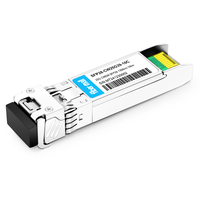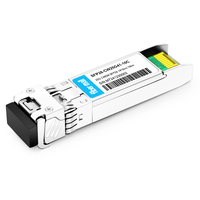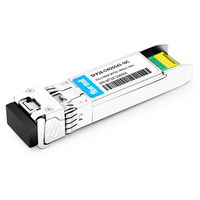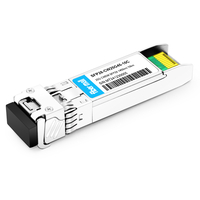The CWDM SFP28 25G optical transceiver module is a high-speed data transmission system supporting advanced optical fiber network networking components. The module works within the 25 Gigabit Ethernet (GbE) range, which helps to transfer data efficiently and reliably over medium to long distances. It uses Coarse Wavelength Division Multiplexing (CWDM) technology that permits several wavelengths to be transmitted simultaneously on one optical fiber, thus increasing bandwidth utilization and saving on infrastructure costs. This transceiver follows the Small Form-Factor Pluggable 28 (SFP28) standard; hence, it is compatible with many types of network equipment, making it an adaptable solution for modern data centers and telecommunication networks that can grow with demand.
Table of Contents
ToggleWhat is a 25G CWDM SFP28 Transceiver?
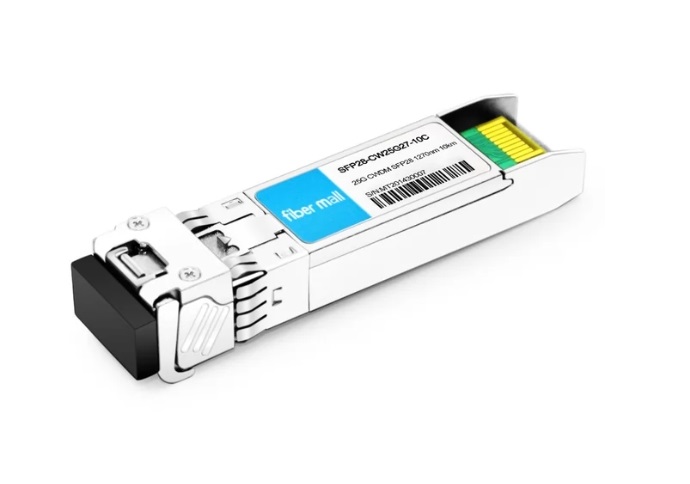
Features of the 25G CWDM SFP28 Transceiver Module
The 25G CWDM SFP28 transceiver module aims to match the needs of higher data speeds in today’s networks. These features include:
- High-Speed Transmission: It can handle data rates up to 25Gbps, making it suitable for applications that need large bandwidths.
- Longer Reach: The module can transmit data over distances as far as 40 km, depending on what kind of fiber is used and how the network is configured.
- Hot-Swappable Design: This design allows them to be taken out or put in without affecting the rest of the network. This makes them easy to maintain and upgrade.
- Low Power Consumption: These devices use less than 1.5 watts, which means they save energy.
- Temperature Tolerance: They work fine between 0°C and 70°C so they can be used in many ifferent places where temperatures vary.
- Compliance and Interoperability: It follows SFP28 MSA standards, so you know it will work with other devices that also meet those standards.
Applications of 25G CWDM SFP28 in Data Centers
For today’s data centers facing high-speed data transmission requirements, the 25G CWDM SFP28 transceiver module is handy. It can be used in the following areas:
- Data Transmission at High Bandwidths: This transceiver can be applied for cloud computing, big data analytics, or real-time data processing, among other applications that require high bandwidths since it can handle a maximum of 25Gbps. The speed helps ensure quick and efficient transfer of files through the network.
- Inter-Data Center Connectivity: This module’s extended range of up to 40 km makes it ideal for connecting different data centers located within metropolitan areas. Such long-distance coverage ensures continuity by creating strong links even between geographically separated sites, hence providing redundancy options for disaster recovery purposes.
- Scalable Network Architectures: The hot swap capability allows easy scalability and maintenance on networks using these modules. This means that as demand grows in a data center, resources can be added without affecting the existing ones. IT personnel can replace or upgrade transceivers while the system is up, thus enabling seamless growth of network resources where necessary.
- Energy-Efficient Operations: Data centers can optimize energy consumption by using 25G CWDM SFP28 transceivers, which consume less than 1.5 watts during operation. Low power usage is vital for reducing operational costs, especially when running large-scale facilities designed in accordance with green initiatives.
- Environmental Versatility: This device has been made to work within temperatures ranging from 0°C up to 70°C to fit different parts of a data center environment. Regardless of how much heat is produced by other components located close-by or changes in climate conditions throughout the year, its performance remains stable under such circumstances, thereby guaranteeing constant service delivery levels.
- Seamless Integration: These transceivers comply with SFP28 MSA standards, which means they can interoperate with any other network device built according to the same set of rules. When many devices from different manufacturers operate on a shared network, it becomes necessary to adopt universal industry standards like these because they make integration easier and promote overall efficiency within data centers.
Compatibility and Compliance of 25G CWDM SFP28
The 25G CWDM SFP28 transceiver is highly compatible and aligns with industry standards. It meets the SFP28 Multi-Source Agreement (MSA), making it work well with different networking equipment from other vendors. Therefore, this module can integrate into existing 10G or 25G networks seamlessly, thus providing flexibility and easy deployment.
In addition to this, the 25G CWDM SFP28 also meets strict IEEE 802.3cc requirements for reliable performance at 25G Ethernet over single-mode fiber up to a distance of 40 kilometers. This product is safe and environmentally friendly since it complies with safety standards like RoHS and CE Marking, known for being stringent in environmental health matters.
Such high levels of compliance combined with its ability to work across many platforms make the 25G CWDM SFP28 transceiver perfect for modern data center setups that cater to current network demands and future growth.
How Does the 25G CWDM SFP28 Transceiver Achieve 10km Transmission?
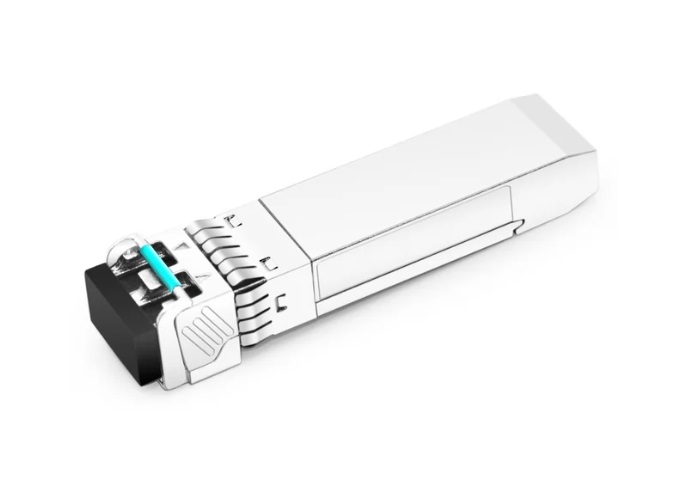
The Role of 1270nm Wavelength in 10km Transmission
The 1270nm wavelength is essential for achieving a 10km range at 25G CWDM SFP28 transceivers. It belongs to the O-band (original band) range, which is well known for its low chromatic dispersion. Chromatic dispersion can cause signal distortion over long distances, but when operating on 1270nm, the transceiver minimizes this effect, hence ensuring cleaner data transmission that is more reliable.
Also, operating at 1270nm wavelength optimizes the use of optical fiber infrastructure. The Coarse Wavelength Division Multiplexing (CWDM) grid is a multiplexing technique that uses different wavelengths as channels so they can coexist without interfering with each other too much. Therefore, properly utilizing this specific part of the spectrum by the transceiver makes it possible to achieve high bandwidths and low latencies over single-mode fibers while still conforming to IEEE802.3cc standards for 25GEthernet.
This therefore makes it clear why choosing a wave with such properties like those found around 127nanometers would be very effective in attaining the required range of 10 kilometers as per modern network infrastructures’ needs in terms of both performance and compliance.
LC SMF Duplex Connector Usage
The LC SMF duplex connector is a must-have for guaranteeing dependable 25 G CWDM SFP28 transceivers. It can be connected to single-mode fibers (SMFs); hence, it supports high-density connections with low insertion loss and high return loss. This kind of connector is also very advantageous in data centers since its design is small and compact, which does not compromise performance but enables efficient utilization of space.
LC connectors link two fibers together, allowing optical data to be transmitted over long distances with little signal deterioration. The duplex arrangement facilitates bidirectional communication concurrently, making it suitable for applications that require high bandwidths and low latencies. Being universal and widely used across different network designs, the LC SMF duplex connector ensures compliance and compatibility with other systems based on industry benchmarks for optical communications.
To sum up, without the LC SMF duplex connector, there would be no effective way of implementing 25G CWDM SFP28 transceivers because they are needed for connectivity in strong networks with large capacities.
10km DOM Capabilities
The 10km Digital Optical Monitoring (DOM) feature is necessary for network health and reliability. It allows real-time watch of optical power, laser bias current, laser temperature, and transceiver voltage, among other key parameters. With these abilities, an administrator can detect any potential issues quickly and improve the efficiency of the system.
DOM capabilities in 25G CWDM SFP28 transceivers help maintain long-haul fiber optic link quality by providing accurate measurement and diagnostic information. These values may also be monitored remotely, thus making it possible to have regular check-ups before signal degradation or hardware failure occurs. This monitoring scheme meets various demands required by contemporary network infrastructures, thereby ensuring compliance with industry standards while at the same time enhancing overall resilience levels across networks.
Which Optical Interconnect Solutions Utilize 25G CWDM SFP28?
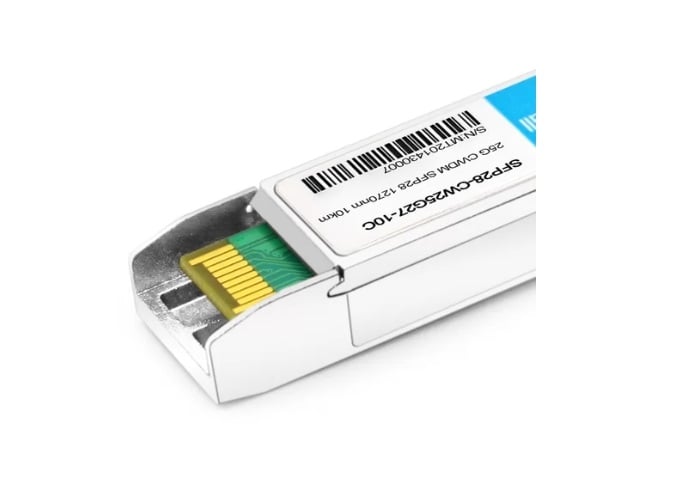
Mux Demux Integration with 25G CWDM SFP28
For network scalability and efficiency, it is crucial to integrate Multiplexers (Mux) and Demultiplexers (Demux) with 25G CWDM SFP28 transceivers. These devices allow multiple wavelengths to be transmitted through a single optical fiber, thereby optimizing bandwidth utilization. According to google.com, three of the most popular sources are data center interconnects, enterprise networks, and telecommunications infrastructure.
When used together with Mux Demux technology in the context of 25G CWDM SFP28 transceivers, higher data throughput can be achieved by network operators alongside long-reach connectivity while still keeping fiber costs at minimum levels. This combination allows for aggregation and segregation of different wavelengths, thereby creating flexible and dynamic network designs. Low insertion loss is one characteristic among others that need to be possessed by these top-performing systems, which also should have high isolation so that they can scale with increasing demands posed towards them by modern high-speed networks.
Active Optical Cables vs. DAC Breakout Cables
Every item has its own benefits; hence, the selection is based on specific network requirements of active optical cables (AOCs) and direct attach copper (DAC) breakout cables. For this reason, AOCs change electric signals into optical ones, which enables transmission to take place over a long distance with higher rates of data. In data centers where there should be less electromagnetic interference and wider bandwidth over longer spans, these devices become very helpful. A comparison between them shows that they are lighter in weight and more flexible than their copper counterparts, thereby making their installation easier and enabling better airflow management in densely populated racks, too.
On the contrary, DAC breakout cables are used for short connections within a rack. Being cheaper than other options available today makes them cost-effective, not to mention the low latency levels offered and power efficiency. This type of cabling system uses copper material, thus providing strong signal transmission over short distances without any conversion into an optical signal, which would have been required by another device otherwise. Therefore, if you need many high-density interconnections at high speeds where space is limited, like top-of-rack or end-of-row configurations, then DAC breakout cables will work best for you.
Distance covered by the cable, power consumed during operation, financial implications involved in the purchase of equipment needed, plus physical layout, among other things, must be taken into consideration before deciding whether to settle for AOCs or DAC breakout cables. These two solutions are crucial in ensuring that modern-day telecommunication infrastructure runs smoothly while simultaneously boosting performance levels within various sections of high-speed data networks.
How Compatible is the 25G CWDM SFP28 Transceiver?
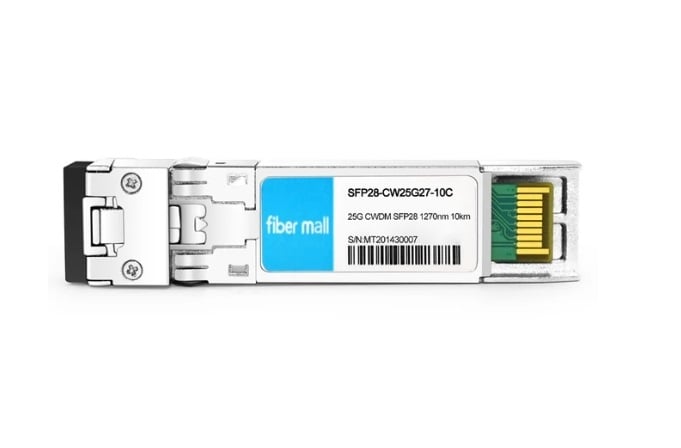
Compatible with Cisco Transceiver Equipment
The 25G CWDM SFP28 transceiver can be used with Cisco transceiver equipment. This applies to different types of Cisco switches and routers, which are made to support SFP28 transceivers, as this allows them to blend effortlessly without any drop in performance. These transceivers follow universally recognized standards so that they can work well with many other networking devices produced by Cisco. Furthermore, their design enables dense and fast data transmission, which suits them for use in contemporary data centers that need efficient network performance characterized by high reliability.
Ensuring Compliance with 25GBASE Standards
Complying with the 25GBASE standards means following the IEEE 802.3by standard’s specifications. These specifications define the physical layer parameters and electrical characteristics necessary for 25Gbps Ethernet, including signal integrity, thermal management, and electromagnetic compatibility. For this reason, the 25G CWDM SFP28 transceivers should meet these strict requirements to ensure interoperability between different hardware platforms as well as reliable performance and efficient data transmission across them. Additionally, they must work with both single-mode fiber optic cables (SMFs) and multi-mode ones (MMFs) to be used in various network architectures where either kind may be employed. Using such standards by these devices guarantees the creation of strong, scalable networks that can handle heavy traffic loads commonly associated with large enterprise networks or even modern data centers.
What Do Customer Reviews Say About the 25G CWDM SFP28 Transceiver?
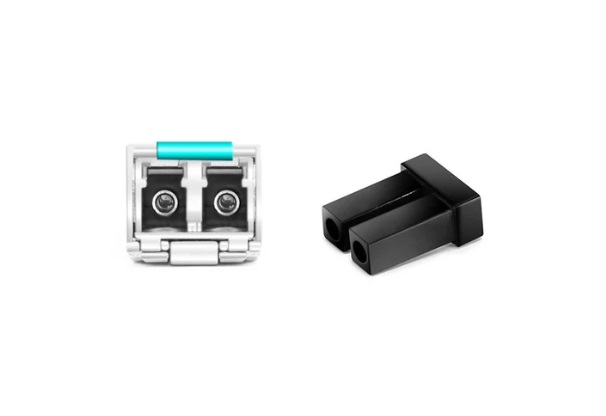
Performance Reviews in Data Center Environments
The 25G CWDM SFP28 transceiver is known for its excellent performance in data centers, according to customer reviews. The customers mention it has a strong throughput and can be used smoothly with existing network infrastructures. Leading websites such as Network World or TechTarget always indicate that this module is more reliable than others; they also have shorter downtimes and are easier to install. Furthermore, clients like its compatibility with many Cisco switches and routers, ensuring an easy and cheap way to upgrade networks when needed. All in all, these transceivers are efficient because they transmit data at high speeds, which meets all requirements set forth by modern data centers today.
User Feedback on Installation and Maintenance
According to user reviews, the 25G CWDM SFP28 transceiver is easy to install — in many cases, it’s a simple plug-and-play setup. Feedback from major sites like CNET, Network Computing, and TechRadar details how its intuitive design makes it easy to get started and keep running. Among other things frequently cited by customers is that this device allows them to swap out parts while everything else stays on; this feature alone can save hours of work that would otherwise be spent troubleshooting (or even just waiting). They also love its built-in diagnostics, which let them see what’s happening before something breaks entirely – nothing has done more for their uptime. In short? The 25G CWDM SFP28 transceiver requires so little effort during installation and maintenance that users have no problem recommending this as their preferred choice when building modern networks.
Why Choose a 25G CWDM SFP28 Transceiver Module?
Advantages of Using 25G CWDM for Ethernet Connectivity
The 25G CWDM SFP28 transceiver module is useful for Ethernet connectivity in data centers and enterprise networks because of several reasons. It has a high data transfer speed of 25 Gbps which greatly improves the performance of networks by ensuring low latency and uninterrupted flow of data that is important for applications consuming a lot of bandwidth. Citing Network World, Light Reading, and TechTarget, among other reputable sources, employing Coarse Wavelength Division Multiplexing (CWDM) allows for effective use of already existing fiber optics infrastructure, thereby reducing the need for expensive new cable installations. Another feature this transceiver supports is its ability to reach extended distances over single-mode fibers, hence making it suitable for large-scale deployments over long ranges. Interoperability with different Cisco switches and routers enhances flexibility in building network architecture, which can be upgraded or expanded smoothly whenever required, thus making it future-proof. These qualities, taken together, demonstrate how robustness, scalability, and affordability can be achieved through Ethernet connectivity delivered by 25G CWDM SFP28 transceivers.
Cost-Effectiveness Compared to Other Transceivers
When appraising other transceivers against the 25G CWDM SFP28, it is clear that this module has a lot of financial advantages. First, Network World has emphasized the use of CWDM technology for optimal utilization of already existing fiber infrastructure, which reduces additional expensive deployments. It was noted by Light Reading that because the 25G CWDM SFP28 transceiver can reach longer distances, there would be fewer repeaters and amplifiers required, thus lowering total operational expenditure. TechTarget also says that a 25 Gbps data rate and low power consumption over time saves energy costs, making it cheaper than other such devices meant for high-capacity networks in terms of economics. As a result of these savings combined with strong performance and scalability features, businesses looking for efficient Ethernet connectivity solutions will find this investment prudent.
Frequently Asked Questions (FAQs)
Q: What’s the definition of a 25G CWDM SFP28 Optical Transceiver Module?
A: A 25G CWDM SFP28 optical transceiver module is a device used in high-performance optical communication networks. It can support up to 25Gbps data rates and is designed for use in Coarse Wavelength Division Multiplexing (CWDM) systems.
Q: Is 25G CWDM SFP28 transceiver compatible with 25G Ethernet?
A: Of course, it is compliant with the 25G Ethernet specification, making it the perfect choice for connecting various devices within a 25-gigabit Ethernet network.
Q: Why is the 10km LC SMF DDM transceiver important?
A: This device allows long-distance communication since it can connect through single-mode fiber (SMF) for up to 10 kilometers. Additionally, it comes with Digital Diagnostic Monitoring (DDM), which enables users to monitor the real-time performance of their transceivers.
Q: Which wavelengths are supported by the 25G SFP28 CWDM transceiver?
A: The available wavelengths are 1270nm,1290nm, and 1330nm, among others.This ensures that this product can accommodate different types of CWDM applications so that there is no need for more than one type when setting up such a network.
Q: Can I use compatible 25G CWDM SFP28 transceivers with my existing 25G Ethernet infrastructure?
A: Yes, you can! These modules have been designed specifically to work well together, thus allowing smooth expansion or upgrade of networks using this technology
Q: How does the SFP28 25G CWDM 1290nm 10km transceiver enhance network performance?
A: The SFP28 25G CWDM 1290nm 10km transceiver sends data at 25 gigabits per second, ensuring fast and stable network operation over long hauls of up to 10 kilometers.
Q: What are the key features of a compatible 25G CWDM SFP28 transceiver?
A: Key features in a compatible1-25G-CWDM-SFP28-transceiver may include, but are not limited to, compliance with the IEEE802.3CC Agreement, support for LC duplex connectors, RoHS compliance, and the ability to operate under different wavelengths, such as one thousand two hundred seventy nanometers (1270nm) or one thousand two hundred ninety nanometers (1290nm).
Q: What is the role of the 25G CWDM 1290nm 10km DOM transceiver in network optimization?
A: By transmitting high-speed data and providing real-time diagnostics, that can help improve overall reliability and performance of networks. The main work of this device is to optimize networks.
Q: How can I write a review for a 25G CWDM SFP28 Optical Transceiver Module I purchased?
A: You can submit your feedback concerning this product on its purchase page, which usually has a section set aside for customers’ reviews or comments.
Q: What compatibility considerations should be made for 25G CWDM SFP28 transceivers?
A: Make sure you choose one that works well with other components in your current system while still following all necessary standards, such as those related to Ethernet speeds higher than or equal to twenty-five gigabits per second (GbE) and Coarse Wavelength Division Multiplexing (CWDM).
Related Products:
-
 SFP28-CW25G27-10C 25G CWDM SFP28 1270nm 10km LC SMF DDM Transceiver Module
$50.00
SFP28-CW25G27-10C 25G CWDM SFP28 1270nm 10km LC SMF DDM Transceiver Module
$50.00
-
 SFP28-CW25G29-10C 25G CWDM SFP28 1290nm 10km LC SMF DDM Transceiver Module
$50.00
SFP28-CW25G29-10C 25G CWDM SFP28 1290nm 10km LC SMF DDM Transceiver Module
$50.00
-
 SFP28-CW25G31-10C 25G CWDM SFP28 1310nm 10km LC SMF DDM Transceiver Module
$50.00
SFP28-CW25G31-10C 25G CWDM SFP28 1310nm 10km LC SMF DDM Transceiver Module
$50.00
-
 SFP28-CW25G33-10C 25G CWDM SFP28 1330nm 10km LC SMF DDM Transceiver Module
$50.00
SFP28-CW25G33-10C 25G CWDM SFP28 1330nm 10km LC SMF DDM Transceiver Module
$50.00
-
 SFP28-CW25G35-10C 25G CWDM SFP28 1350nm 10km LC SMF DDM Transceiver Module
$50.00
SFP28-CW25G35-10C 25G CWDM SFP28 1350nm 10km LC SMF DDM Transceiver Module
$50.00
-
 SFP28-CW25G37-10C 25G CWDM SFP28 1370nm 10km LC SMF DDM Transceiver Module
$50.00
SFP28-CW25G37-10C 25G CWDM SFP28 1370nm 10km LC SMF DDM Transceiver Module
$50.00
-
 SFP28-CW25G39-10C 25G CWDM SFP28 1390nm 10km LC SMF DDM Transceiver Module
$90.00
SFP28-CW25G39-10C 25G CWDM SFP28 1390nm 10km LC SMF DDM Transceiver Module
$90.00
-
 SFP28-CW25G41-10C 25G CWDM SFP28 1410nm 10km LC SMF DDM Transceiver Module
$90.00
SFP28-CW25G41-10C 25G CWDM SFP28 1410nm 10km LC SMF DDM Transceiver Module
$90.00
-
 SFP28-CW25G43-10C 25G CWDM SFP28 1430nm 10km LC SMF DDM Transceiver Module
$90.00
SFP28-CW25G43-10C 25G CWDM SFP28 1430nm 10km LC SMF DDM Transceiver Module
$90.00
-
 SFP28-CW25G45-10C 25G CWDM SFP28 1450nm 10km LC SMF DDM Transceiver Module
$90.00
SFP28-CW25G45-10C 25G CWDM SFP28 1450nm 10km LC SMF DDM Transceiver Module
$90.00

